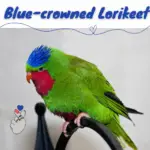
Stephen’s Lorikeet 19cm; 42–55 g. Similar to V. kuhlii but lacks purplish-blue nape and has broken green breastband, less bright rump, and longer, wedge-shaped all-yellowish tail. Immature has mostly green underparts.
Systematics History
Monotypic.
Subspecies
Monotypic.
Distribution
Henderson I, in the Pitcairn Group (E Polynesia).
Habitat
Native forest, which covers the island.
Movement
Sedentary.
Diet and Foraging
A variety of food types, including nectar, pollen, fruit, and insect larvae, from canopy level in coconut palms to ground-level shrubs, species involved being: nectar and/or pollen from Scaevola sericea, Timonius polygamus (these two the key plants),
Cyclophyllum, Xylosma suaveolens, Thespesia populnea, Cordia subcordata, Psydrax, Senecio, Cocos nucifera and Pandanus tectorius, fruits of Eugenia rare flora, Nesoluma st-johnianum, Guettardia speciosa and Timonius polygamus, “juice” of Caesalpinia leaves, and lepidopteran larvae from the sporangia of Phymatosorus ferns.
Sounds and Vocal Behavior
The commonest call of Stephen’s Lorikeet is a fast trisyllabic (or modulated) “tsililit” given when perched. In-flight, a similar but more piercing “tseet!”.
Breeding
No information except specimens with developing gonads was collected in Apr, and a female had an enlarged ovary in May.
Conservation Status
VULNERABLE. CITES II. A BirdLife “restricted-range” species. Numbers were estimated in 1987 at 720–1820 birds and in 1992 at 2400 birds.
The population is essentially secure so long as no settlement of its 37km² sole home is attempted, bringing with it the increased chance of colonization by black rats (Rattus rattus); one such attempt was headed off in 1983.




















